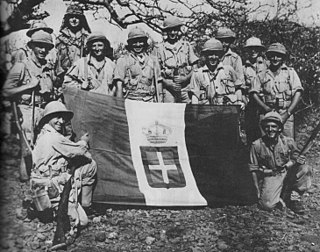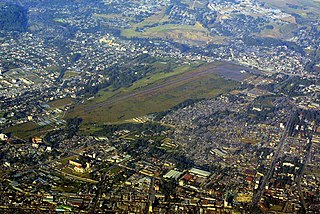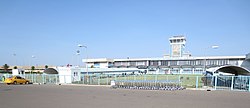
Ethiopian Airlines, formerly Ethiopian Air Lines (EAL), is the flag carrier of Ethiopia, and is wholly owned by the country's government. EAL was founded on 21 December 1945 and commenced operations on 8 April 1946, expanding to international flights in 1951. The firm became a share company in 1965 and changed its name from Ethiopian Air Lines to Ethiopian Airlines.

The East African campaign was fought in East Africa during the Second World War by Allies of World War II, mainly from the British Empire, against Italy and its colony of Italian East Africa, between June 1940 and November 1941. The British Middle East Command with troops from the United Kingdom, South Africa, British India, Uganda Protectorate, Kenya, Somaliland, West Africa, Northern and Southern Rhodesia, Sudan and Nyasaland participated in the campaign. These were joined by the Allied Force Publique of Belgian Congo, Imperial Ethiopian Arbegnoch and a small unit of Free French Forces.

Addis Ababa Bole International Airport is an international airport in Addis Ababa, Ethiopia. It is in the Bole district, 6 km (3.7 mi) southeast of the city centre and 65 km (40 mi) north of Bishoftu. The airport was formerly known as Haile Selassie I International Airport. It is the main hub of Ethiopian Airlines, the national airline that serves destinations in Ethiopia and throughout the African continent, as well as connections to Asia, Europe, North America and South America. The airport is also the base of the Ethiopian Aviation Academy. As of June 2018, nearly 380 flights per day were using the airport.
Eritrean Airlines is the national airline of Eritrea. Based at Asmara International Airport, it is wholly owned by the government of Eritrea. Scheduled service had been discontinued since 2008, and the airline operated only a few hajj flights every year. The airline was restarted under new management in 2011. In 2011, Nasair, a privately owned company, merged with government-owned Eritrean Airlines, to form Nasair Eritrea. Eritrean Airlines has been banned from flying into the European Union (EU) since December 2012. As of July 2023, Eritrean Airlines had no scheduled service.

The Caproni Ca.133 was a three-engined transport/bomber aircraft used by the Italian Regia Aeronautica from the Second Italo-Abyssinian War until World War II.

Ala Littoria S.A. was the Italian national airline that operated during the fascist regime in the 1930s and 1940s.

Aden Adde International Airport, formerly known as Mogadishu International Airport, is an international airport serving Mogadishu, the capital of Somalia. It is named after Aden Abdullah Osman Daar, the first President of Somalia.

Massawa International Airport is an airport in Massawa, a major city in the Northern Red Sea region of Eritrea. It is considered to be the successor of the Otumlo Airport, also in Massawa, which was destroyed in 1941.
Assab International Airport is an international airport in Assab, the capital of the Southern Red Sea region of Eritrea.
Articles related to Eritrea include:
Wadi Halfa Airport is an airport serving Wadi Halfa in Sudan. The airport is approximately 14 kilometres (8.7 mi) east of Wadi Halfa.

The Ethiopian Navy, known as the Imperial Ethiopian Navy until 1974, is a branch of the Ethiopian National Defense Force founded in 1955. It was disestablished in 1996 after the independence of Eritrea in 1991 left Ethiopia landlocked. In 2019 the Ethiopian Navy was re-established based in Bahir Dar, Amhara region, near Lake Tana.

Castel Benito was an airport of Tripoli created by the Italians in Italian Libya. Originally, it was a small military airport, but it was enlarged in the late 1930s and was later used by the British RAF after 1943. It was called RAF Castel Benito by the Allies.

Castel Benito was an airport of Tripoli created by the Italians in Italian Libya in the early 1930s. It was called RAF Castel Benito by the Allies after 1943.

Italians of Ethiopia are Ethiopian-born citizens who are fully or partially of Italian descent, whose ancestors were Italians who emigrated to Ethiopia starting in the 19th century during the Italian diaspora, or Italian-born people in Ethiopia.

Lideta Airport also colloquially known as the Old Airport is a decommissioned military airport located in Addis Ababa, Ethiopia.

Gura or Gura'e is a settlement in Eritrea's Debub region in northeast Africa. It is located in the eponymous Gura Valley in the southeastern Eritrean highlands. It is about 9 kilometers (5.6 mi) SE of Dekemhare and about 32 kilometres (20 mi) SSE of the capital Asmara.

The Italian colonial railways started with the opening in 1888 of a short section of line in Italian Eritrea, and ended in 1943 with the loss of Italian Libya after the Allied offensive in North Africa and the destruction of the railways around Italian Tripoli. The colonial railways of the Kingdom of Italy reached 1,561 kilometres (970 mi) before WWII.

The Imperial Line was a flight route of the Italian national airline Ala Littoria between 1935 and 1941 during the Fascist era. It was the longest route in the Italian colonial empire in Africa and "the jewel in Ala Littoria's crown". It connected Rome with Benghazi (Libya), Asmara (Eritrea), Addis Abeba (Ethiopia) and Mogadishu (Somalia). It carried passengers and mail. Italy ultimately lost control of the route during World War II.

The Petrella Airport was the first international airport in Italian Somalia. It was opened in 1928 -just 3 miles south of Mogadishu- with the name "Enrico Petrella" in honor of an Italian pilot who died a few years before in the same airport of Italian Mogadiscio. In 1941 the airport was partially destroyed during WW2 and remained inactive for some years as a civilian airport: only military airplanes used it. In 1950 was reopened as a civilian airport by the Italian authorities of the ONU Fiduciary Mandate.

















